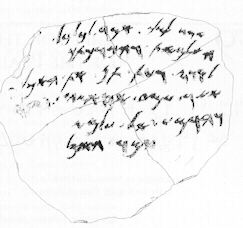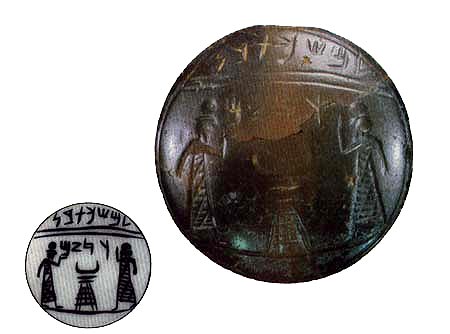Ostrakon from Ḥorvat ‘uza (7th-6th century BC)

l. 1: ′MR LMLK ′MR LBLBL
l. 2: HŠLM ′T WHBRKTK
l. 3.: LḲWS W‘T TN ′T H′KL
l. 4: ′ŠR ‘MD ′H′MH [...]
l. 5: WHRM ‘[Z]′L ‘L MZ[BḤ ...]
l. 6: [...] HMR H′KL
"Lmlk said: 'Tell Blbl «Are you fine? I bless you on behalf of Qaus. Now give the food ′h′mh brought (?) [...] and ‘[z]′l will raise it up (= will offer it) upon the al[tar...] [... (lest?)] the food leavens(?)»'" The ostrakon is part of the correspondence between a man named Lmlk (one high officer?) and a second unnamed individual, who must in his turn report a message to a certain Blbl (the commander in chief of the stronghold?). This letter was unearthed in one of the Judaean fortifications built in the eastern Negev by the end of the 7th century, in order to stop Edomite advance; nevertheless, the three individuals seem to share the cult to Qaus, Edom's 'national' god, indicating that they are most probably of Edomite origin. At the time the letter was written, then, the stronghold had probably already fallen under Edomite control, which favours a date between 595-594 or 588-586 BC for the redaction of the letter itself. The text bears an administrative mark, as it refers to the delivery of some kind of food, perhaps unleavened dough, by the hand of the messenger. The last three lines are very badly damaged, but the few readable words leave the impression that the food to be delivered was meant for ritual offerings.
Stone seal from ‘En Azeva (7-6th century BC.)

Source: Israel Antiquities Authority
l. 1: LMSKT BN
l. 2: WḤZM
"(Belonging) to Mskt, son of Wḥzm"
This stone seal was discovered in an Edomite stronghold in the Negev, and bears the image of two men standing one in front of the other, on both sides of a horned altar.